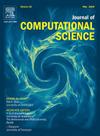PPEIM: A preference path-based early-stage influence accumulation model for influential nodes identification in locally dense multi-core networks
IF 3.1
3区 计算机科学
Q2 COMPUTER SCIENCE, INTERDISCIPLINARY APPLICATIONS
引用次数: 0
Abstract
The identification of influential nodes, a critical problem in the field of complex networks, has been extensively studied. However, previous research has primarily focused on maximizing terminal influence across all network structures indiscriminately, making it challenging to accurately identify influential nodes in specific structures. Moreover, overlooking the influence of the temporal dynamics of propagation significantly diminishes the benefits of identifying influential nodes. Therefore, we propose an influential nodes identification model, Preference Path-based Early-stage Influence Accumulation Model (PPEIM), tailored for typical locally dense multi-core networks. The key idea of PPEIM is to identify more influential nodes in early-stage propagation by aggregating dynamic influence propagation volumes superimposed on multiple paths. Specifically, early-stage influence performance is enhanced by sampling paths, mitigating the risk of dense influential nodes resulting from redundant relationships. Moreover, the K-shell, degree, influence distance and link direction are integrated to define connection strength between nodes to guide path selection. And the concept of influence propagation volume is introduced to accurately simulate the influence residuals and losses during the propagation process. To validate the effectiveness and superiority of PPEIM in locally dense multi-core networks, five sets of simulation experiments are conducted on seven real-world datasets. Experimental results demonstrate that PPEIM outperforms six state-of-the-art methods in overall propagation capability, early-stage influence capability, disintegration capability, node dispersion, and discrimination capability.
PPEIM:一种基于偏好路径的局部密集多核网络影响节点识别早期影响积累模型
影响节点的识别是复杂网络领域的一个关键问题,已经得到了广泛的研究。然而,以往的研究主要集中在不分青红皂白地最大化所有网络结构的终端影响,这使得准确识别特定结构中的影响节点具有挑战性。此外,忽略传播时间动态的影响会大大降低识别有影响节点的好处。因此,针对典型的局部密集多核网络,我们提出了一种基于偏好路径的早期影响积累模型(PPEIM)。PPEIM的核心思想是通过聚合叠加在多个路径上的动态影响传播体,识别早期传播中影响较大的节点。具体而言,通过采样路径增强了早期影响性能,降低了冗余关系导致的密集影响节点的风险。并综合k壳、度、影响距离、链路方向来定义节点间的连接强度,指导路径选择。并引入影响传播体积的概念,准确模拟了影响传播过程中的影响残差和损失。为了验证PPEIM在局部密集多核网络中的有效性和优越性,在7个真实数据集上进行了5组仿真实验。实验结果表明,PPEIM在整体传播能力、早期影响能力、解体能力、节点分散能力和识别能力等方面都优于6种最先进的方法。
本文章由计算机程序翻译,如有差异,请以英文原文为准。
求助全文
约1分钟内获得全文
求助全文
来源期刊

Journal of Computational Science
COMPUTER SCIENCE, INTERDISCIPLINARY APPLICATIONS-COMPUTER SCIENCE, THEORY & METHODS
CiteScore
5.50
自引率
3.00%
发文量
227
审稿时长
41 days
期刊介绍:
Computational Science is a rapidly growing multi- and interdisciplinary field that uses advanced computing and data analysis to understand and solve complex problems. It has reached a level of predictive capability that now firmly complements the traditional pillars of experimentation and theory.
The recent advances in experimental techniques such as detectors, on-line sensor networks and high-resolution imaging techniques, have opened up new windows into physical and biological processes at many levels of detail. The resulting data explosion allows for detailed data driven modeling and simulation.
This new discipline in science combines computational thinking, modern computational methods, devices and collateral technologies to address problems far beyond the scope of traditional numerical methods.
Computational science typically unifies three distinct elements:
• Modeling, Algorithms and Simulations (e.g. numerical and non-numerical, discrete and continuous);
• Software developed to solve science (e.g., biological, physical, and social), engineering, medicine, and humanities problems;
• Computer and information science that develops and optimizes the advanced system hardware, software, networking, and data management components (e.g. problem solving environments).
 求助内容:
求助内容: 应助结果提醒方式:
应助结果提醒方式:


